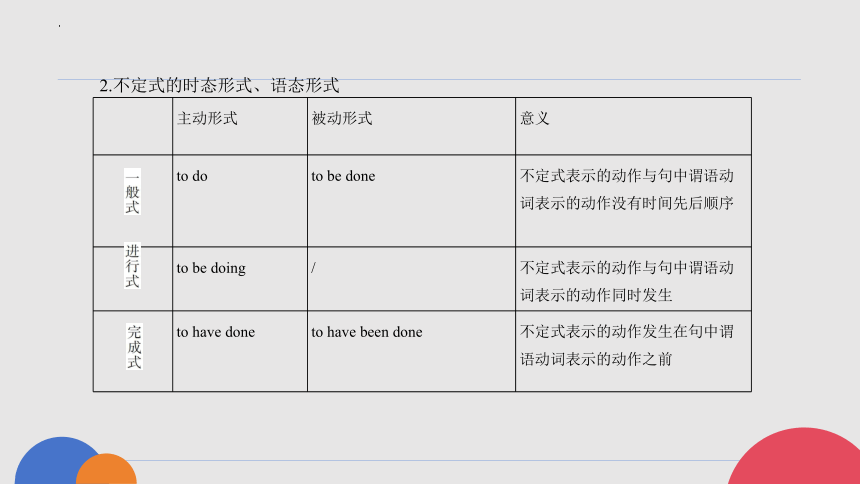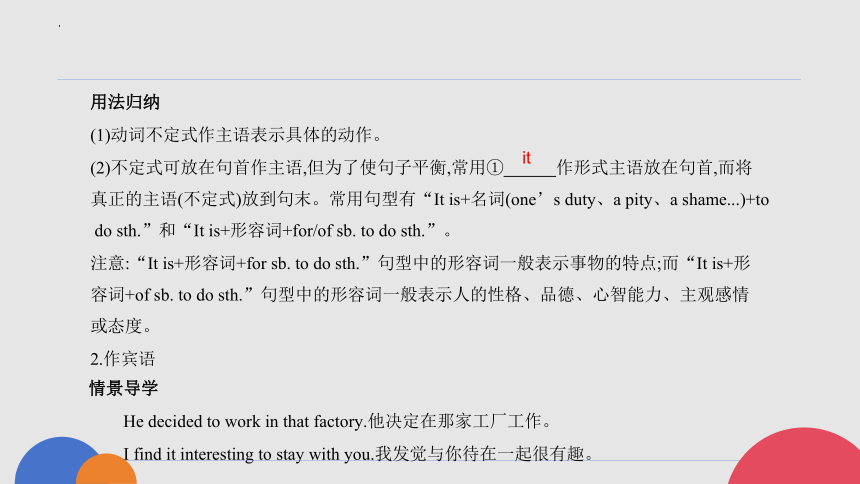北师大版(2019)必修第一册Unit1 Life Choices语法知识课件(共21张PPT)
文档属性
| 名称 | 北师大版(2019)必修第一册Unit1 Life Choices语法知识课件(共21张PPT) |  | |
| 格式 | pptx | ||
| 文件大小 | 2.4MB | ||
| 资源类型 | 教案 | ||
| 版本资源 | 北师大版(2019) | ||
| 科目 | 英语 | ||
| 更新时间 | 2024-04-16 16:35:32 | ||
图片预览









文档简介
(共21张PPT)
Unit 1 Life Choices
语法知识精讲
so...that...和so that
...I work so much that I feel I don t see my family enough. ……我工作如此多,以至于我
感到没有足够的时间和家人待在一起。 (教材P101)
I am always attentive in all classes and think actively, so that I can have more free time to
do other things that I m interested in after school.我在所有课上总是专心听讲并积极思考,以
便放学后我就有更多空闲时间做我感兴趣的其他事情。
结构1
’
’
It was so hot a day that nobody wanted to do anything.天气如此热,谁也不想做任何事情。
Unit 1 Life Choices
单元语法知识精讲
用法归纳
①so...that...表示“如此……以至于……”,引导 状语从句。
so...that...的基本结构:
so+ /adv.+that...
so+ +a/an+可数名词单数+that...
so+ /few+可数名词复数+that...
so+much/little+ +that...
②so that可引导 状语从句,意为“以便,为了”,也可引导 状语从句,意为
“结果,因此”。so that引导目的状语从句时,从句中常使用can、could、may、might等情
态动词;so that引导结果状语从句时,从句中一般不用类似的情态动词,so that前可以有逗
号。
结果
adj.
adj.
many
不可数名词
介词
结果
结构拓展
such...that...也可引导结果状语从句。such...that...的基本结构:
(1)such+a/an+adj.+可数名词单数+that...
Ms. Yang is such a responsible teacher that all the students love her very much.杨老师
是一位如此负责任的老师,所有学生都很爱她。
(2)such+adj.+可数名词复数/不可数名词+that...
He told such funny stories that we all laughed.他讲了如此滑稽的故事,以至于我们都
笑了。
find+宾语+宾语补足语
I find waiting for exam results very stressful.我觉得等待考试结果非常有压力。 (教材
结构2
用法归纳
①在“find+宾语+宾语补足语”结构中,宾语通常为名词(短语)或代词,宾语补足语可
由名词(短语)、形容词(短语)、副词、 短语、 (短语)(表宾语在进行的主动动作)、 (短语)(表被动或完成)等充当。
②当不定式短语或从句作宾语时,为了保持句子的结构平衡,通常用 作形式宾
语,而将真正的宾语放在宾语补足语后面。
介词
现在分词
过去分词
it
动词不定式
不定式虽然不能单独作谓语,但保留着动词的某些特征,可带自己的宾语和状语,从而形成
不定式短语。不定式(短语)在句中可作主语、宾语、宾语补足语、表语、定语及状语。
一、不定式的基本形式和否定式
1.不定式的基本形式和否定式
不定式的基本形式是“to+动词原形”,其否定式是在其前加上not。
He warned me to take an umbrella.他提醒我带把雨伞。
He warned me not to be late.他提醒我不要迟到。
主动形式 被动形式 意义
to do to be done 不定式表示的动作与句中谓语动词表示的动作没有时间先后顺序
to be doing / 不定式表示的动作与句中谓语动词表示的动作同时发生
to have done to have been done 不定式表示的动作发生在句中谓语动词表示的动作之前
2.不定式的时态形式、语态形式
二、不定式的功能
1.作主语
情景导学
To learn English well is very important.学好英语很重要。
It is a great pleasure to talk with him.与他谈话是一件乐事。
It’s kind of you to help me with my English.你帮我学英语真是太好了。
用法归纳
(1)动词不定式作主语表示具体的动作。
(2)不定式可放在句首作主语,但为了使句子平衡,常用① 作形式主语放在句首,而将
真正的主语(不定式)放到句末。常用句型有“It is+名词(one’s duty、a pity、a shame...)+to
do sth.”和“It is+形容词+for/of sb. to do sth.”。
注意:“It is+形容词+for sb. to do sth.”句型中的形容词一般表示事物的特点;而“It is+形
容词+of sb. to do sth.”句型中的形容词一般表示人的性格、品德、心智能力、主观感情
或态度。
2.作宾语
it
情景导学
He decided to work in that factory.他决定在那家工厂工作。
I find it interesting to stay with you.我发觉与你待在一起很有趣。
用法归纳
(1)有些动词后只能跟不定式作宾语。
(2)动词不定式作宾语且后面有宾语补足语时,常用② 作形式宾语,把真正的宾语(不
定式)放在宾语补足语之后。
it
巧学助记
用动词不定式作宾语的动词:
三个希望俩答应(hope, wish, want, agree, promise)
两个要求莫拒绝(demand, ask, refuse)
设法学会做决定(manage, learn, decide, determine)
不要假装在选择(pretend, choose, elect)
打算提出俩计划(intend, offer, plan, mean)
申请失败付得起(apply, fail, afford)
准备愿望又碰巧(prepare, desire, happen)
3.作宾语补足语
情景导学
The teacher advised us to learn through experiment. 老师建议我们通过实验来学习。
We heard him say goodbye to his friends. 我们听见他向他的朋友们道别。
→He was heard to say goodbye to his friends. 他被听到向他的朋友们道别。
He often comes to help us (to) do some farm work. 他经常来帮我们干一些农活。
用法归纳
(1)可以用动词不定式作宾语补足语的动词(短语)有ask、tell、order、want、get、would
like、advise、invite、allow、wish、warn、expect、encourage、force、teach等,不定式的符
号to ③ 省略。
(2)有些使役动词和感官动词(短语),如feel、hear、listen to、have、let、make、notice、
see、watch、observe、look at等,在主
动结构中跟不带to的动词不定式作宾语补足语,在变为被动形式时,不定式作主语补足语,不
能省略④ 。
(3)动词⑤ 接动词不定式作宾语补足语时,不定式的符号to可省略也可不省略。
4.作表语
不能
to
help
情景导学
My hope is to become a scientist. 我希望成为一名科学家。
My job is to teach English. 我的工作是教英语。
用法归纳
动词不定式作表语可表示主语的责任或义务、主语将来的行为或主语的内容或性
质。
5.作定语
情景导学
The farmers came up with ways to protect their crops. 农民们想出了保护庄稼的方法。
He was the last one to arrive at the classroom this morning. 今天早上他是最后一个到教
室的。
Would you please give me some paper to write on 你能给我一些纸写字吗
用法归纳
(1)动词不定式可作后置定语,修饰前面的名词。
(2)常用结构:the+序数词/the+形容词最高级/the very/the only/the ⑥ +名词/代词+to
do。
(3)作定语的不定式若为不及物动词,或者不定式所修饰的名词或代词是不定式动作的地
点、工具等,其后须有与之搭配的介词。如果被不定式修饰的名词为place、time、way时,
不定式后面的介词习惯上可以省去。
6.作状语
动词不定式作状语,可表示目的、结果、原因等。
last
情景导学
To/In order to get there before eight, I started early. 为了在八点以前到达那里,我很早就动身
了。
I am very sorry to hear that. 听到这件事我很难过。
He searched the room only to find nothing. 他搜查了那个房间,结果什么也没发现。
用法归纳
(1)表目的。为了强调表示目的的不定式结构,可在不定式前加上⑦ 或so
as, 但so as to do一般不放在句首。
(2)表原因。动词不定式放在系表结构后面,表示产生某种情绪或状态的原因。
(3)表结果。so/such...as to...、too...to...、...enough to...等结构中的不定式表示结果,而⑧
to do常表示出乎意料的结果。
三、“疑问词+不定式”结构
in order
only
情景导学
When to hold the meeting has not been decided. 什么时候开会还没有决定。
At four months old, the two little tigers were learning how to open doors and jump fences.
四个月大的时候,这两只小老虎正在学习如何开门和跳过篱笆。
用法归纳
who、what、which、⑨ 、where和 等特殊疑问词后接不定式可以构
成一种特殊的不定式短语,常在句子中作主语、宾语、表语等。
-ed/-ing 形容词
一、概述
有些动词的-ed形式可用作形容词,描述人的情感,通常意为“感到……的”。有些动
词的-ing形式可用作形容词,描述情境、人或事物,通常意为“令人……的;使人……的”。
但在expression、look(表情)、face、smile、voice等词前,常用-ed形式的形容词。
二、句法功能
when
how
情景导学
They were frightened when they heard that the lion had got out of its cage.他们听说那头
狮子从笼子里逃脱后,感到害怕。
Many people enjoy relaxing music in the evening prior to going to bed.许多人在晚上睡觉
前喜欢听令人放松的音乐。
I found the book so interesting that I kept on reading it until daybreak.我发现这本书如此
有趣,以至于我一直读到黎明。
After the long journey, the three of them went back home, hungry and tired.长途旅行后,
他们三个回到家,又饿又累。
用法归纳
-ed形式的形容词和-ing形式的形容词可以在句中作 、表语、宾语补足语和
状语。
三、常见的-ed形式的形容词和-ing形式的形容词
interested感兴趣的→interesting有趣的
excited兴奋的→exciting令人兴奋的
surprised惊奇的→surprising令人惊奇的
astonished吃惊的→astonishing令人十分惊讶的
frightened害怕的→frightening令人害怕的
embarrassed尴尬的→embarrassing令人尴尬的
disappointed失望的→disappointing令人失望的
定语
即时巩固
单句语法填空
1.Cao decided (cover) the route by hiking as a tribute(致敬)to the an-
cient Silk Road.
2.One way to begin is (answer) your own excuses.
3.The parents were asked (interact) with their children as they nor-
mally would, and about half of the children in the study played with puzzles at one time.
4.Tom took a taxi to the airport only (find) his plane high up in the sky.
5.It is a great honor for me (have) an opportunity to attend the interview here today.
6.Lost in despair, the fellow didn’t know how (handle) the embarrassing situation.
to cover
to answer
to interact
to find
to have
to handle
7.Emma says it’s (challenge) to be a health expert, because
people can be easily influenced by advertisements that lack scientific support.
8.In their spare time, they are (interest) in planting vegetables in their garden,
which is on the rooftop of their house.
9.Stephanie gave me a (disappoint) look, and left Nelson’s room, followed by my
dad.
10.On seeing the scene, the little girl was so that she burst out crying.
(frighten)
challenging
interested
disappointed
frightening
frightened
Unit 1 Life Choices
语法知识精讲
so...that...和so that
...I work so much that I feel I don t see my family enough. ……我工作如此多,以至于我
感到没有足够的时间和家人待在一起。 (教材P101)
I am always attentive in all classes and think actively, so that I can have more free time to
do other things that I m interested in after school.我在所有课上总是专心听讲并积极思考,以
便放学后我就有更多空闲时间做我感兴趣的其他事情。
结构1
’
’
It was so hot a day that nobody wanted to do anything.天气如此热,谁也不想做任何事情。
Unit 1 Life Choices
单元语法知识精讲
用法归纳
①so...that...表示“如此……以至于……”,引导 状语从句。
so...that...的基本结构:
so+ /adv.+that...
so+ +a/an+可数名词单数+that...
so+ /few+可数名词复数+that...
so+much/little+ +that...
②so that可引导 状语从句,意为“以便,为了”,也可引导 状语从句,意为
“结果,因此”。so that引导目的状语从句时,从句中常使用can、could、may、might等情
态动词;so that引导结果状语从句时,从句中一般不用类似的情态动词,so that前可以有逗
号。
结果
adj.
adj.
many
不可数名词
介词
结果
结构拓展
such...that...也可引导结果状语从句。such...that...的基本结构:
(1)such+a/an+adj.+可数名词单数+that...
Ms. Yang is such a responsible teacher that all the students love her very much.杨老师
是一位如此负责任的老师,所有学生都很爱她。
(2)such+adj.+可数名词复数/不可数名词+that...
He told such funny stories that we all laughed.他讲了如此滑稽的故事,以至于我们都
笑了。
find+宾语+宾语补足语
I find waiting for exam results very stressful.我觉得等待考试结果非常有压力。 (教材
结构2
用法归纳
①在“find+宾语+宾语补足语”结构中,宾语通常为名词(短语)或代词,宾语补足语可
由名词(短语)、形容词(短语)、副词、 短语、 (短语)(表宾语在进行的主动动作)、 (短语)(表被动或完成)等充当。
②当不定式短语或从句作宾语时,为了保持句子的结构平衡,通常用 作形式宾
语,而将真正的宾语放在宾语补足语后面。
介词
现在分词
过去分词
it
动词不定式
不定式虽然不能单独作谓语,但保留着动词的某些特征,可带自己的宾语和状语,从而形成
不定式短语。不定式(短语)在句中可作主语、宾语、宾语补足语、表语、定语及状语。
一、不定式的基本形式和否定式
1.不定式的基本形式和否定式
不定式的基本形式是“to+动词原形”,其否定式是在其前加上not。
He warned me to take an umbrella.他提醒我带把雨伞。
He warned me not to be late.他提醒我不要迟到。
主动形式 被动形式 意义
to do to be done 不定式表示的动作与句中谓语动词表示的动作没有时间先后顺序
to be doing / 不定式表示的动作与句中谓语动词表示的动作同时发生
to have done to have been done 不定式表示的动作发生在句中谓语动词表示的动作之前
2.不定式的时态形式、语态形式
二、不定式的功能
1.作主语
情景导学
To learn English well is very important.学好英语很重要。
It is a great pleasure to talk with him.与他谈话是一件乐事。
It’s kind of you to help me with my English.你帮我学英语真是太好了。
用法归纳
(1)动词不定式作主语表示具体的动作。
(2)不定式可放在句首作主语,但为了使句子平衡,常用① 作形式主语放在句首,而将
真正的主语(不定式)放到句末。常用句型有“It is+名词(one’s duty、a pity、a shame...)+to
do sth.”和“It is+形容词+for/of sb. to do sth.”。
注意:“It is+形容词+for sb. to do sth.”句型中的形容词一般表示事物的特点;而“It is+形
容词+of sb. to do sth.”句型中的形容词一般表示人的性格、品德、心智能力、主观感情
或态度。
2.作宾语
it
情景导学
He decided to work in that factory.他决定在那家工厂工作。
I find it interesting to stay with you.我发觉与你待在一起很有趣。
用法归纳
(1)有些动词后只能跟不定式作宾语。
(2)动词不定式作宾语且后面有宾语补足语时,常用② 作形式宾语,把真正的宾语(不
定式)放在宾语补足语之后。
it
巧学助记
用动词不定式作宾语的动词:
三个希望俩答应(hope, wish, want, agree, promise)
两个要求莫拒绝(demand, ask, refuse)
设法学会做决定(manage, learn, decide, determine)
不要假装在选择(pretend, choose, elect)
打算提出俩计划(intend, offer, plan, mean)
申请失败付得起(apply, fail, afford)
准备愿望又碰巧(prepare, desire, happen)
3.作宾语补足语
情景导学
The teacher advised us to learn through experiment. 老师建议我们通过实验来学习。
We heard him say goodbye to his friends. 我们听见他向他的朋友们道别。
→He was heard to say goodbye to his friends. 他被听到向他的朋友们道别。
He often comes to help us (to) do some farm work. 他经常来帮我们干一些农活。
用法归纳
(1)可以用动词不定式作宾语补足语的动词(短语)有ask、tell、order、want、get、would
like、advise、invite、allow、wish、warn、expect、encourage、force、teach等,不定式的符
号to ③ 省略。
(2)有些使役动词和感官动词(短语),如feel、hear、listen to、have、let、make、notice、
see、watch、observe、look at等,在主
动结构中跟不带to的动词不定式作宾语补足语,在变为被动形式时,不定式作主语补足语,不
能省略④ 。
(3)动词⑤ 接动词不定式作宾语补足语时,不定式的符号to可省略也可不省略。
4.作表语
不能
to
help
情景导学
My hope is to become a scientist. 我希望成为一名科学家。
My job is to teach English. 我的工作是教英语。
用法归纳
动词不定式作表语可表示主语的责任或义务、主语将来的行为或主语的内容或性
质。
5.作定语
情景导学
The farmers came up with ways to protect their crops. 农民们想出了保护庄稼的方法。
He was the last one to arrive at the classroom this morning. 今天早上他是最后一个到教
室的。
Would you please give me some paper to write on 你能给我一些纸写字吗
用法归纳
(1)动词不定式可作后置定语,修饰前面的名词。
(2)常用结构:the+序数词/the+形容词最高级/the very/the only/the ⑥ +名词/代词+to
do。
(3)作定语的不定式若为不及物动词,或者不定式所修饰的名词或代词是不定式动作的地
点、工具等,其后须有与之搭配的介词。如果被不定式修饰的名词为place、time、way时,
不定式后面的介词习惯上可以省去。
6.作状语
动词不定式作状语,可表示目的、结果、原因等。
last
情景导学
To/In order to get there before eight, I started early. 为了在八点以前到达那里,我很早就动身
了。
I am very sorry to hear that. 听到这件事我很难过。
He searched the room only to find nothing. 他搜查了那个房间,结果什么也没发现。
用法归纳
(1)表目的。为了强调表示目的的不定式结构,可在不定式前加上⑦ 或so
as, 但so as to do一般不放在句首。
(2)表原因。动词不定式放在系表结构后面,表示产生某种情绪或状态的原因。
(3)表结果。so/such...as to...、too...to...、...enough to...等结构中的不定式表示结果,而⑧
to do常表示出乎意料的结果。
三、“疑问词+不定式”结构
in order
only
情景导学
When to hold the meeting has not been decided. 什么时候开会还没有决定。
At four months old, the two little tigers were learning how to open doors and jump fences.
四个月大的时候,这两只小老虎正在学习如何开门和跳过篱笆。
用法归纳
who、what、which、⑨ 、where和 等特殊疑问词后接不定式可以构
成一种特殊的不定式短语,常在句子中作主语、宾语、表语等。
-ed/-ing 形容词
一、概述
有些动词的-ed形式可用作形容词,描述人的情感,通常意为“感到……的”。有些动
词的-ing形式可用作形容词,描述情境、人或事物,通常意为“令人……的;使人……的”。
但在expression、look(表情)、face、smile、voice等词前,常用-ed形式的形容词。
二、句法功能
when
how
情景导学
They were frightened when they heard that the lion had got out of its cage.他们听说那头
狮子从笼子里逃脱后,感到害怕。
Many people enjoy relaxing music in the evening prior to going to bed.许多人在晚上睡觉
前喜欢听令人放松的音乐。
I found the book so interesting that I kept on reading it until daybreak.我发现这本书如此
有趣,以至于我一直读到黎明。
After the long journey, the three of them went back home, hungry and tired.长途旅行后,
他们三个回到家,又饿又累。
用法归纳
-ed形式的形容词和-ing形式的形容词可以在句中作 、表语、宾语补足语和
状语。
三、常见的-ed形式的形容词和-ing形式的形容词
interested感兴趣的→interesting有趣的
excited兴奋的→exciting令人兴奋的
surprised惊奇的→surprising令人惊奇的
astonished吃惊的→astonishing令人十分惊讶的
frightened害怕的→frightening令人害怕的
embarrassed尴尬的→embarrassing令人尴尬的
disappointed失望的→disappointing令人失望的
定语
即时巩固
单句语法填空
1.Cao decided (cover) the route by hiking as a tribute(致敬)to the an-
cient Silk Road.
2.One way to begin is (answer) your own excuses.
3.The parents were asked (interact) with their children as they nor-
mally would, and about half of the children in the study played with puzzles at one time.
4.Tom took a taxi to the airport only (find) his plane high up in the sky.
5.It is a great honor for me (have) an opportunity to attend the interview here today.
6.Lost in despair, the fellow didn’t know how (handle) the embarrassing situation.
to cover
to answer
to interact
to find
to have
to handle
7.Emma says it’s (challenge) to be a health expert, because
people can be easily influenced by advertisements that lack scientific support.
8.In their spare time, they are (interest) in planting vegetables in their garden,
which is on the rooftop of their house.
9.Stephanie gave me a (disappoint) look, and left Nelson’s room, followed by my
dad.
10.On seeing the scene, the little girl was so that she burst out crying.
(frighten)
challenging
interested
disappointed
frightening
frightened
同课章节目录
- Unit 1 Life Choices
- Lesson 1 Lifestyles
- Lesson 2 Understanding and Coping with Stress
- Lesson 3 Your Life Is What You Make It
- Unit 2 Sports and Fitness
- Lesson 1 The Underdog
- Lesson 2 Rules of the Game
- Lesson 3 Running and Fitness
- Unit 3 Celebrations
- Lesson 1 Spring Festival
- Lesson 2 Special Occasions
- Lesson 3 Memories of Christmas
